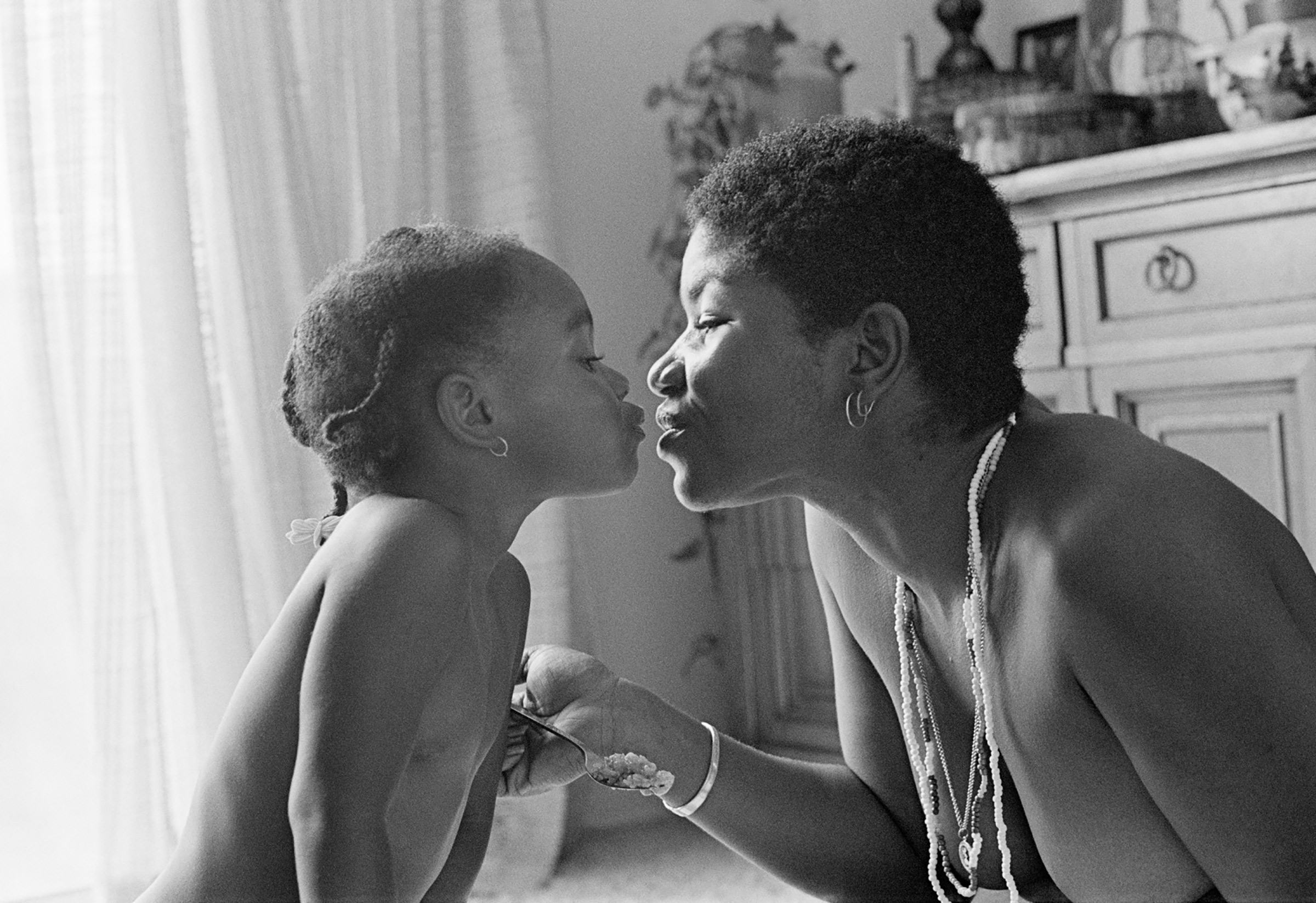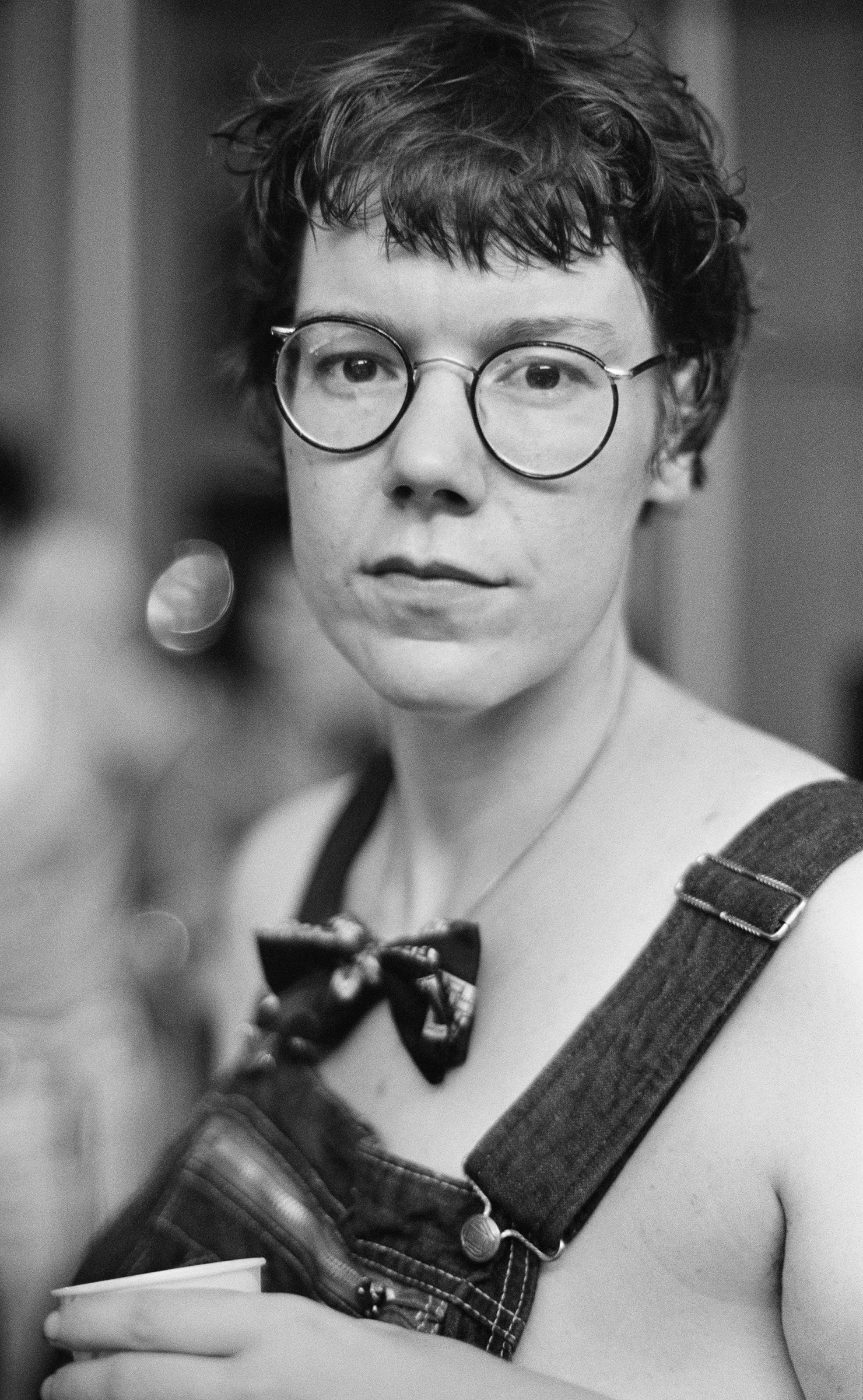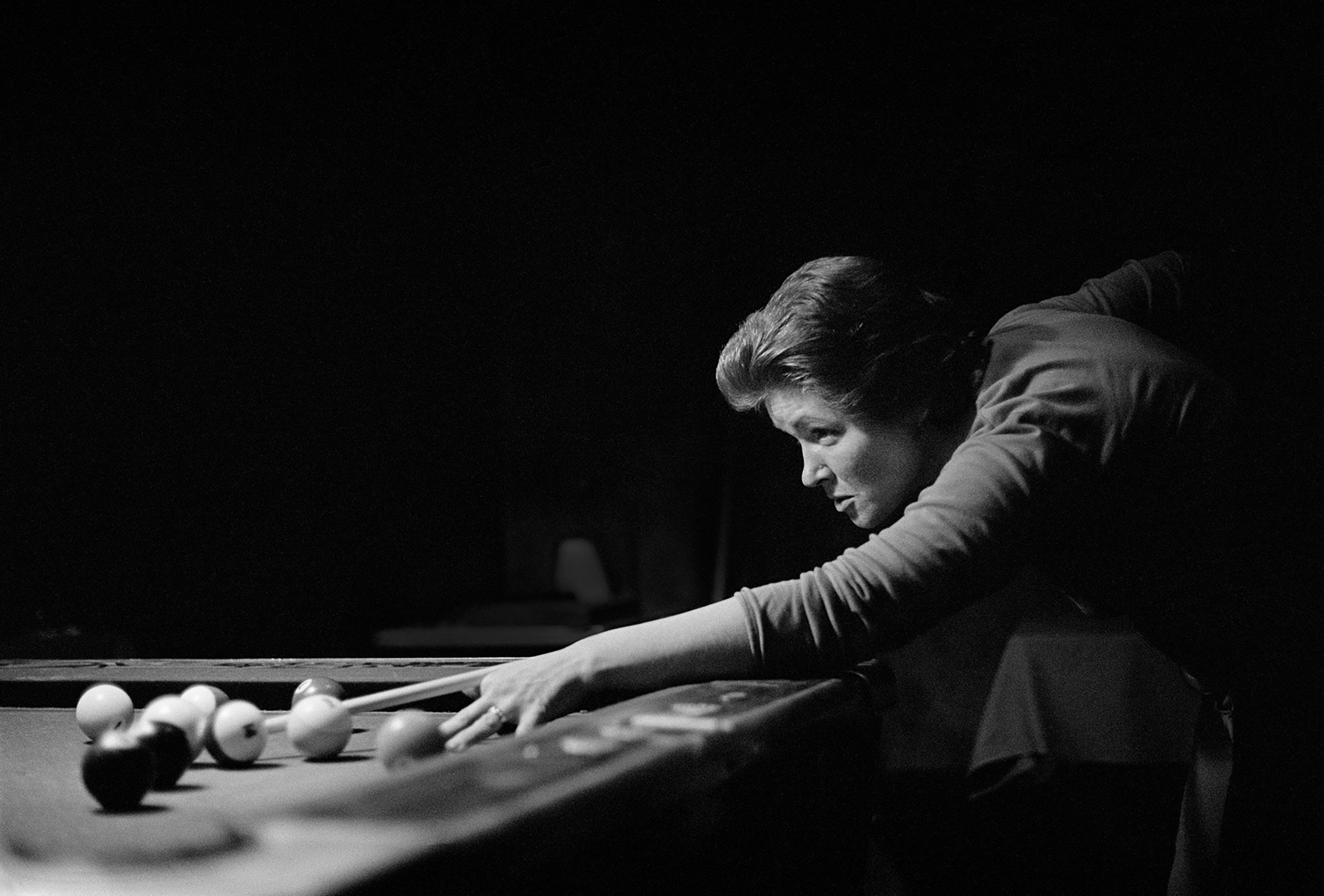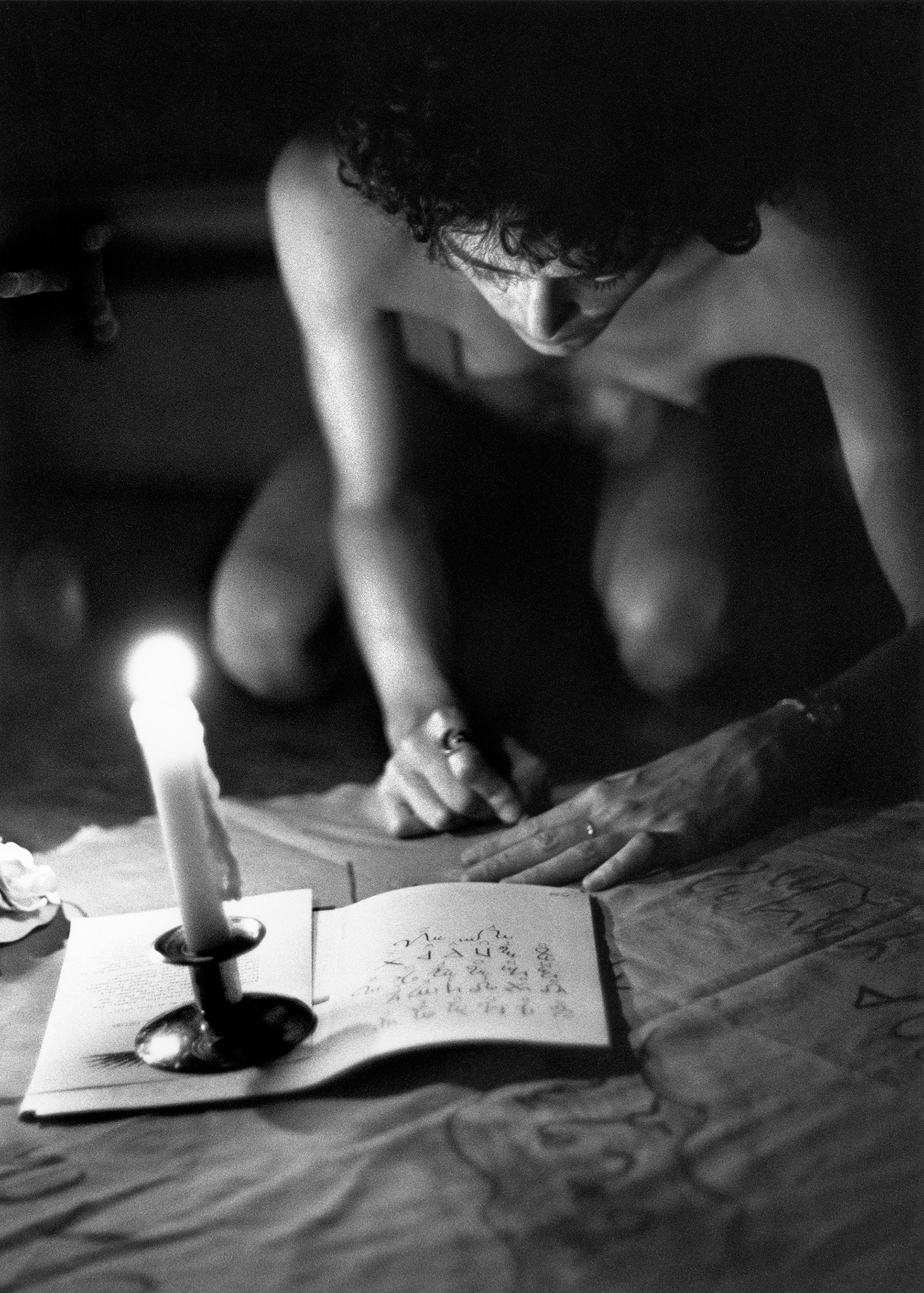JEB (Joan E. Biren) has proudly called herself a ‘radical lesbian feminist’ for years. A founding member of a collective of like-minded members called The Furies, she turned her passion for research and “absolute inability to find lesbian images” into a quest for greater lesbian visibility. The desire to see not only herself but other lesbians, and to find historical connections to gay women, led her to produce photo books, direct documentaries, and tour the country with a now-legendary slide show between 1979 and 1985 called “Lesbian Images in Photography: 1850-the present,” also known as the “Dyke Show.”
JEB’s first book, Eye to Eye: Portraits of Lesbians, self-published in 1979, is now being re-released by Anthology Editions. It may be hard to conceive today of just how high the stakes were for her to publish a book of “out lesbians” more than four decades ago. The printer even made her acquire a second set of releases before it went to press, causing some of the subjects to lose their nerve. A 1979 article in Unicorn Times, an underground art newspaper published in Washington, D.C., places the moment into perspective:
It is almost impossible to publish photos of lesbian mothers with their children because of the mother’s fears of losing their children in custody cases. Mothers are not the only lesbians who can’t be photographed. Women afraid of losing their jobs, lesbians from other countries afraid of deportment, and lesbians afraid of disownment from their families all had to refuse Biren’s permission to be published.
Ahead of the re-release of Eye to Eye, JEB spoke to TIME about the roots of her activism during her upbringing in Washington D.C., her years fighting to be seen and the joys of revisiting her archive.
TIME: Can you tell me how your activism began?
JEB: Both of my parents were civil servants. I wanted to go into politics through Congress to make policy. And I majored in political science. Then I came out as a lesbian, and that was in the ’60s before there was a (gay rights) movement and I thought, that ended my political career as an elected official.
It was also the Vietnam War at a time when my father worked in the Pentagon. It caused a big split in our family because I was very antiwar. I went to England to study politics at Oxford University and spent most of my time working with people who were trying to get soldiers in the underground railroad—deserters—into a safe place in Scandinavia. I think that really what made me an activist was the Vietnam war and knowing that if I was going to affect politics and policy, it would be as an outsider, because I was a lesbian.
When I came back from England I got involved with the Women’s Liberation Movement. I was thrown out of my consciousness-raising group when my lover and I came out as lesbians. I spent a lot of time finding other lesbians. I found most of them at the Black Panther Party convention in Philadelphia. They were from New York, and I convinced a bunch to move to Washington, D.C. That was the beginning of a lesbian feminist movement here. We formed a collective called the Furies, and we published a newspaper where I first published my photographs.
Although we were all white, I was told that because of my privileged education, even though I came from a very middle-class family, I knew how to argue verbally very well. I was told basically that I needed to shut up to make room for other people to speak. That is the genesis of my becoming a photographer.

Can you tell me how your interest in the history of photography began?
My love of research and my absolute inability to find lesbian images led me to work to uncover what I believed were lesbian images. However, there was no book to go to. There was just mostly my gut feeling. It’s very hard to feel like you don’t have a history. Everyone wants to feel part of something larger than themselves. Gay and lesbian people particularly often get estranged from their blood families. So you’re always looking for, “Where do you belong?” At that time, there were very few histories, never mind visual histories.
When I found these images, I was moved to share them with other people—lesbians in particular—and my friend Tee Corinne, who was a photographer, was traveling with a slideshow of erotic lesbian imagery. She encouraged me to do a slideshow too. Often at my slideshows, people would say, “Oh, my gosh, I had no idea that there were that many lesbians in this town,” because it was the first time they had all come together for anything.
I would do a workshop for photographers. I saw a lot of pictures of lesbians’ cats, because people brought what they were photographing. But I also saw some amazing work. When I was in San Francisco, Del LaGrace Volcano came to a workshop of mine. A lot of people who came to my workshops were actually photography students who could not show the lesbian work they were doing in their schools. I think I served a real purpose of encouraging people to keep doing that work. If they were photographing lesbians and not their cats.

Can you kind of tell me about realizing you were starting to have a body of work, and that you wanted to make a book?
There weren’t any books of lesbian photography that said that it was lesbians inside the book. And I needed it. Just like I needed that first lesbian photograph that I made, that turns out was a selfie—I made by holding the camera out because I didn’t even know anybody who could take a picture of me kissing my lover. And that wanting to see images of myself, I knew it was not just something that I felt. I knew all the lesbians who were beginning to be out felt that same hunger, as well as closeted lesbians.
The thing that made the book possible was that enough lesbians were willing and courageous enough to say they were lesbians and have their face in a book. That’s why it happened when it happened. It could not have happened before then.
It feels like you had a lot of foresight in thinking about representation. The book opens up with a beautiful Black couple followed by all these different types of people. Could you talk about how that all came together?
That was a direct result of the politics that I had at the time. It wasn’t just me. I was part of a political movement that was very focused on classism and racism. We were very conscious of the kinds of inequalities that existed in the society we were part of. And we were trying to do anti-racist work. And we were socialists.
I worked very hard not to put out a book until I thought I had at least a fairly good representation. But you’ll see in my dedication I wrote at the beginning of the book, “Much of what I would have liked to include is missing. Perhaps I should have subtitled the book Only Portraits and of Just a Very Few Lesbians.”

When I look at lesbian writers and Black lesbian writers like Audre Lorde, the conversation they were having about race and diversity seems so far ahead of the mainstream media culture. Was that the case?
We didn’t have the word intersectionality back then, but we really did believe in intersectional politics. However, if you would ask this question of the Black lesbians in the ’70s, like Barbara Smith, they would tell you the movement was still very white-dominated and not anti-racist enough.
However, if you were listening to the Black women, as more and more people have learned to do today, then, yes, you would have a more progressive, more revolutionary politic that was more anti-racist. I think the lesbian movement that I was part of where we called ourselves radical lesbian feminists was more like that than you might have said was the lesbian movement in general.
I do think that the lesbians at the time were more progressive than the gay men. We had less privilege. If you have a lot of privilege, you have to unlearn that. So as white people may have to unlearn their privilege, it was the same with the men, who had to unlearn the privilege they had because of sexism.
Aside from the photographs, you included lots of writing that you curated so carefully. Could you talk a little bit about the intention there?
Well, the intention was not to just have it be my voice or my vision, my photographs, but to celebrate the lesbian culture that was beginning to be so amazing at that point. The lesbian poets—Audre Lorde, Adrienne Rich—were the rock stars of the lesbian movement at that time. I wanted to share as much of that as I could.

What was the reaction like in the 1979? Do you remember people reviewing it or mailing it back to you?
Not only did people not mail it back to me, but for years I would go into my local gay bookstore to their secondhand section. It was never there. Never! Today people are all telling me they still have the one they bought in 1979. I had to go immediately to print a Second Edition because the hunger for these is so immense. This book really filled the void, and the reception was amazing.
I’ve continued to hear all these years about how this book was a lifesaver. People would find it in bookstores and hide in the corner to look at it. This book made them feel not alone, not like a freak, not sick.
I gave a copy to my college library (Mt. Holyoke), and it was stolen—maybe like seven times. Eventually, they had to lock it up in the stacks, where they had this cage with all the rare books from the Middle Ages.

That’s amazing. I love that it’s in the special section.
The reception exceeded my expectations. Even though I knew the hunger was there.
There is a new generation that has discovered your work for the first time. I definitely include myself, seeing your work in Aperture’s Queer issue a few years ago. Why do you think it was left out of other history books?
I think the reason you didn’t know about it was that I never considered myself part of the art world. I was always part of the political world. Nobody knew who I was, and I took that for granted. I didn’t expect anybody to know who I was outside of the community that I was making the work for. And honestly, I’m just glad I lived this long to be able to see it.
I knew in my heart that the work was going to be important as a documentary. When I was a young photographer, I saw Diana Davies and other people’s work from the Civil Rights Movement of the ’60s, displayed at the Smithsonian Institution. I said to myself, keep working. Someday you’ll be dead, but your work—when they recognize that the LGBTQ movement was important in the way that the Black Civil Rights Movement was being recognized—your work will be in the Smithsonian. I lived to see that. I lived to see my work in the Smithsonian 10 feet tall on a pillar.

White queer men have been given disproportionate attention in the history of photography. We’re now in a reckoning that inspiring a reevaluation of history and who’s told it, and that includes more women and people of color. I think your work is part of that reckoning.
I had to fight for it. I actually fought for many years before I’d gotten my work shown in the windows of the Leslie-Lohman Museum in New York. I walked into that museum and said, “Why don’t you have lesbians here?”
When Jonathan D. Katz did Hide/Seek at the National Portrait Gallery, I went to him and asked, “Why aren’t I in this show?” So, that took a certain amount of guts. And as a result of that, Jonathan Katz ended up curating a show called Lesbians Seeing Lesbians at Leslie-Lohman. But only because I complained, I think.

I think that’s so brave. A lot of photographers are afraid to rock the boat. But you really fought for your work.
Well, the reason is that I never thought of it as me, the artist. I always thought of it as lesbian representation is not happening in a place where it should be happening. And I continue to fight for representation of other lesbian photographers who I feel are not being given the recognition they deserve also.
Why didn’t you put your full name on the cover of the book? Why did you go with the acronym JEB?
I adapted that acronym in the beginning because I believed that if I had a short name, people would give me credit. Because I was just publishing in newspapers and magazines.
When I was a kid, I pulled my initials out of a cereal box with these little stick-on letters and put them on my bike. And I liked how it looked, and I thought it sounded butchier, too. So for those reasons, I chose to be JEB in my photography life. And now I’m trying to bring the two names together.

In revisiting the work to republish the book, were there any new discoveries? Did anything surprising happen along the way?
We started with the idea that we would just republish the exact volume. Along the way, we added a couple of new essays to place it in a context. But we went back to the film negatives with the advances in scanning technology. The thing that I discovered was that when I made these photographs, I was incredibly self-critical and full of doubt about my ability as a photographer.
When you’re self-taught, you are always going to doubt whether you’re doing it the right way. I had gained some confidence in the 40-plus years since then, and when I went back with my today eyes, I thought to myself, “Hey, these aren’t bad!” I liked my own work in a way now that I did not then.
What is it like to see the book kind of reborn?
The thing that excites me about it the most is that it will be available to younger generations of lesbians and people because it’s going to be on a wider stage now. People besides this rather small lesbian community that existed in the 1970s are going to be able to hear about it, and that’s just amazing to me.

More Must-Reads from TIME
- Cybersecurity Experts Are Sounding the Alarm on DOGE
- Meet the 2025 Women of the Year
- The Harsh Truth About Disability Inclusion
- Why Do More Young Adults Have Cancer?
- Colman Domingo Leads With Radical Love
- How to Get Better at Doing Things Alone
- Michelle Zauner Stares Down the Darkness
Contact us at letters@time.com
